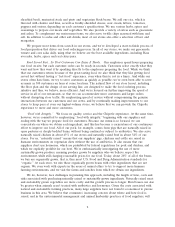Chipotle 2005 Annual Report Download - page 16
Download and view the complete annual report
Please find page 16 of the 2005 Chipotle annual report below. You can navigate through the pages in the report by either clicking on the pages listed below, or by using the keyword search tool below to find specific information within the annual report.We may not persuade customers of the benefits of paying our prices for higher-quality food.
Our success depends in large part on our ability to persuade customers that food made with
higher-quality ingredients is worth the prices they will pay at our stores relative to prices offered by
some of our competitors, particularly those in the quick-service segment. We may not successfully
educate customers about the quality of our food, and they may not care even if they do understand our
approach. That could require us to change our pricing, advertising or promotional strategies, which
could materially and adversely affect our results or the brand identity that we’ve tried to create.
Changes in customer tastes and preferences, spending patterns and demographic trends could cause sales
to decline.
Changes in customer preferences, general economic conditions, discretionary spending priorities,
demographic trends, traffic patterns and the type, number and location of competing restaurants affect
the restaurant industry. Our success depends to a significant extent on consumer confidence, which is
influenced by general economic conditions and discretionary income levels. Our sales may decline
during economic downturns, which can be caused by various economic factors such as high gasoline
prices, or during periods of uncertainty, such as those that followed the terrorist attacks on the United
States in 2001. Similarly, hurricanes Katrina and Rita are affecting consumer confidence and are likely
to affect our supply costs, near-term construction costs for our new stores and may affect our sales
going forward. Any material decline in consumer confidence or a decline in family ‘‘food away from
home’’ spending could cause our sales, operating results, profits, business or financial condition to
decline. If we fail to adapt to changes in customer preferences and trends, we may lose customers and
our sales may deteriorate.
Competition from other restaurant companies could adversely affect us.
We operate in the fast-casual segment of the restaurant industry. This segment is highly
competitive with respect to, among other things, taste, price, food quality and presentation, service,
location and the ambiance and condition of each restaurant. We also compete with restaurants in the
quick-service and casual dining segments. Our competition includes a variety of locally owned
restaurants and national and regional chains. Our competitors offer dine-in, carry-out and delivery
services. Many of our competitors have existed longer and often have a more established market
presence with substantially greater financial, marketing, personnel and other resources than Chipotle.
Our parent, McDonald’s, operates in the quick-service segment of the restaurant industry. Among our
main competitors are a number of multi-unit, multi-market Mexican food or burrito restaurant
concepts, some of which are expanding nationally. As we expand further in existing markets, our
existing stores may face competition from our new stores that begin operating in those markets.
Several of our competitors compete by offering menu items that are specifically identified as low in
carbohydrates, better for customers or otherwise targeted at particular consumer preferences. Many of
our competitors in the fast-casual and quick-service segments of the restaurant industry also emphasize
lower-cost, ‘‘value meal’’ menu options, a strategy we don’t pursue. Our sales may be adversely affected
by these products and price competition.
Moreover, new companies may enter our markets and target our customers. For example,
additional competitive pressures have come more recently from the deli sections and in-store caf´
es of
several major grocery store chains, including those targeted at customers who want higher-quality food,
as well as from convenience stores and casual dining outlets. These competitors may have, among other
things, lower operating costs, better locations, better facilities, better management, more effective
marketing and more efficient operations.
All of these competitive factors may adversely affect us and reduce our sales and profits.
10
























